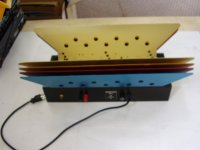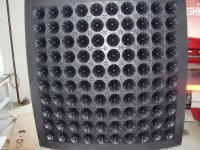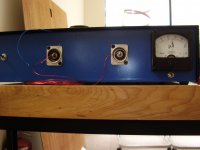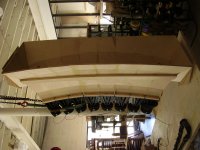But it is non-linear distortion that's being discussed at the moment.
se
Ah, thanks for clearing that up, but what is linear distortion?
The artifacts from nonlinear path elements and ones with hysteresis are quite different. Sort of the difference between being dragged behind a speeding car or being in front of one when it hits the concrete wall.
Have an annealing furnace too?
Coolness!
I need some leather bits punched. Interested?
se
Annealing furnace? Doesn't everyone? Time and temperature controlled tempering furnace capable of decent sword lengths is on the list of toys I don't have... yet.
Is the leather still attached to anyone? Never tried it, bet it would bind and gum up things, do you have any idea at what a service call costs!
Ah, thanks for clearing that up, but what is linear distortion?
Where the signal is modified by a linear function.
se
Annealing furnace? Doesn't everyone? Time and temperature controlled tempering furnace capable of decent sword lengths is on the list of toys I don't have... yet.
Then what do you plan to do with those laminations after you punch them out?
Is the leather still attached to anyone? Never tried it, bet it would bind and gum up things, do you have any idea at what a service call costs!
So what can your machine do? Just punch metal and cardboard?
se
Yes, I am, and please forgive me, I could ONLY measure at the lowest input level that I could practically measure with my ST 1700B analyzer. This is a relatively HIGH level of input (to the test equipment), but it appears to TRACK with level. I don't have a SPECIFIC WORST CASE OUTPUT AT 1/2 Hz, but comparison between two almost identical transformers makes me concerned.
John,
It should not be too difficult, also with normal test gear, to check when core saturation sets in.
You don't need to simulate the tiny voltages of the cartridge.
Amplitude and frequency behave linear when saturation must be checked.
To be more clear, when I know that my line level input transformer can withstand 6 VRMS at 20 Hz before core saturation occurs, this means that the core can have 12 VRMS at 40 Hz, or 3 VRMS at 10 Hz.
What I still would like to know: was your measurement somehow comparable with the real situation (cartridge-transformer)? Therefore we need to know your voltage level at 10 Hz. If your gear does not allow, then put in more voltage at some higher frequency. Once more: core saturation is clearly visible on the scope.
Sure. But John's not comparing an amorphous core transformer to a steel core transformer.
I know.
Also, "amorphous" by itself doesn't really tell you anything. You can get amorphous in steel, nickel and cobalt.
I know, but all these materials have high permeability and low hysteresis loss in common.
What John's comparing is an amorphous cobalt core transformer to an 80% nickel laminated core transformer.
I know.
So you're saying the amorphous cobalt core is saturating sooner than the 80% nickel laminated core?
Yes.
Amorphous cobalt material has 0.56T, 80% nickel about 0.8T.
se
Of course, Pieter.
Of course what??
Of course what??
You know.
What you said.
Sheesh, you don't even know what you said?
se
My tools hardly work but here are some of the toys I have made.
Coolness!
I'll look elsewhere for someone with more modern, more sophisticated equipment who can manage to die cut leather.
se
Not the funniest Python skit.
.
You know.
What you said.
Sheesh, you don't even know what you said?
se
OK,
As quick as I popped in here so quick will I pop out.
When you guys, reputations or not, don't take the effort to give proper replies I don't put more time in this; enough other things to do
It is 1 AM here, good night.
bet it would bind and gum up things
Yawei Nisshinbo turret punch ?
You've got to be kidding, even as low as 60punches/min is no problem with leather.
Which is what i did during childhood days, punching leather straps for fire extinguisher holders inside Belgian army vehicles, contract my old man had.
For the record, everybody put some money toward me answering Pieter's question:
Yes, I had to do the test over. Took me about 1 hour.
Pieter could have done it, himself, but here goes:
1933, mumetal transformer 0.1V out, 10 ohm drive, 50K load, 10Hz distortion is 0.072%.
1931, Amorphous transformer 0.1V out, 10 ohm drive, 50K load, 10H distortion is 1.2%.
This is a distortion increase of about 20 times between the two units.
13.5 mV drive voltage.
Your distortion may vary.
Yes, I had to do the test over. Took me about 1 hour.
Pieter could have done it, himself, but here goes:
1933, mumetal transformer 0.1V out, 10 ohm drive, 50K load, 10Hz distortion is 0.072%.
1931, Amorphous transformer 0.1V out, 10 ohm drive, 50K load, 10H distortion is 1.2%.
This is a distortion increase of about 20 times between the two units.
13.5 mV drive voltage.
Your distortion may vary.
Of course, I used an input signal as low as practically possible and the distortion TRACKED with level AND frequency....
For the record, everybody put some money toward me answering Pieter's question:
Yes, I had to do the test over. Took me about 1 hour.
Pieter could have done it, himself, but here goes:
1933, mumetal transformer 0.1V out, 10 ohm drive, 50K load, 10Hz distortion is 0.072%.
1931, Amorphous transformer 0.1V out, 10 ohm drive, 50K load, 10H distortion is 1.2%.
This is a distortion increase of about 20 times between the two units.
13.5 mV drive voltage.
Your distortion may vary.
Well then there you have it. The laminated hi nickel core clearly whomps the amorphous cobalt core in the low frequency distortion department.
So what are you going to do now, John?
se
- Status
- Not open for further replies.
- Home
- Member Areas
- The Lounge
- John Curl's Blowtorch preamplifier part II



